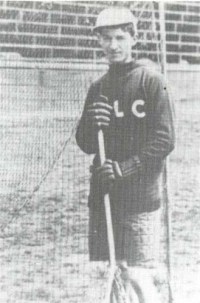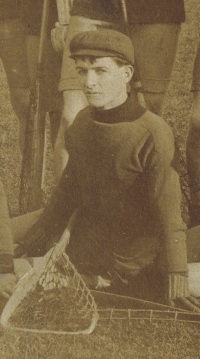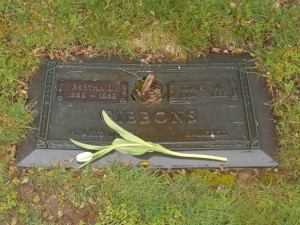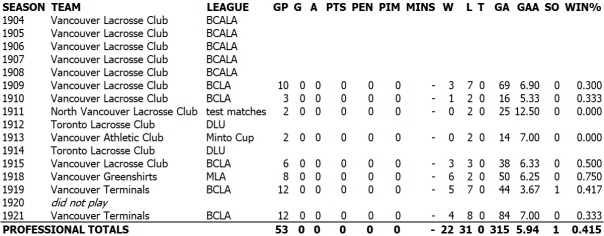
DAVID WALTER (DAVE) GIBBONS II
(February 22, 1884 – October 6, 1966)
Vancouver Lacrosse Club (1904-1910; 1915)
North Vancouver Lacrosse Club (1911)
Toronto Lacrosse Club (1912; 1914)
Vancouver Athletic Club (1913)
Vancouver ‘Greenshirts’ (1918)
Vancouver Terminals (1919; 1921)
Dave Gibbons was born in St. Paul, Minnesota. His father was born in Ireland while his mother was an American and his family moved to Canada when he was a youngster around 1890, ending up in Burnaby, British Columbia. Regardless his background, he was readily accepted as a local product by the Vancouver fans.
He started out in Vancouver junior lacrosse around 1900 with the East End Crescents, spending around four years with that team before later going back east to play for the Argonauts team. Gibbons was back on the Coast when he made his senior lacrosse debut in 1904 for Vancouver Lacrosse Club as a call-up from the intermediate ranks, graduating to the seniors full-time in 1905. He then became a mainstay with the Vancouver Lacrosse Club as the senior amateur game transitioned into the early professional years.
While highly-regarded as a goaltender, his career during the professional era played out more as being stuck in the role of a perennial, stop-gap replacement that Vancouver teams would fall back on during rough times when their prime, starting keepers became unavailable. Despite the frequent accolades about his talent and ability, he often seemed eclipsed by other well-known goaltenders who were signed by Vancouver.
During the 1910 season, a group of local players consisting of Dave Gibbons, George Matheson, Ernie Murray, and ‘Toots’ Clarkson quit the team in early June after they went to Con Jones with demands for more money. Eastern imports Johnny Howard, ‘Bones’ Allen, Harry Griffith, and Harry Pickering were all rumoured to be receiving $50 per week while the four upshots ‘held up Jones’ for more pay because they were only getting half that amount per week – but felt they were doing the lion’s share of the hard work while the imports reaped all the benefits. Despite the hold-outs having a lot of sympathy from the local fans, Jones refused their demand of $40 per week. Gibbons, Murray, and Clarkson quit the team for the rest of the season while Matheson eventually re-joined the team in August. Ernie Murray would sign with cross-town rivals New Westminster in 1911. Con Jones quickly replaced Gibbons with Eastern import Alban ‘Bun’ Clark.

Gibbons would resurface the following year playing for the North Vancouver Lacrosse Club entry trying to gain admittance into the professional league. Two lopsided losses in test matches against New Westminster and Vancouver, in which Gibbons conceded a total of 25 goals, sealed the fate of the would-be third team in the British Columbia Lacrosse Association and their application was quickly rejected. He amicably reconciled with Con Jones and spent the rest of the 1911 season watching from the sidelines as the spare goaltender for the Vancouver Lacrosse Club, although he saw no action during their successful Minto Cup championship run that year and did not appear in the team photograph.
Dave Gibbons married Bertha Burnett, of Tacoma, Washington, on April 11, 1912 in Vancouver. He then left for Ontario when the Toronto Lacrosse Club signed Gibbons for the 1912 Dominion Lacrosse Union season, having his most successful season in his career as the ‘Torontos’ ended up winning the league with 14 wins in 18 games.
Gibbons returned to the Coast the following year and found himself picked up by the Vancouver Athletic Club when the Mann Cup champions made their jump to the professional ranks and challenged the New Westminster Salmonbellies for the Minto Cup. Dave Gibbons and his opposite Alban ‘Bun’ Clark hold the distinction of being the two goalkeepers in the only meaningful meeting ever played between current Mann Cup and Minto Cup champions. Gibbons’s team would go down in defeat 9-1 and 5-3.
In 1914, the Athletics would join the professional league full-time but went with Byron ‘Boss’ Johnson as their keeper. Gibbons decided to re-sign with the Toronto Lacrosse Club for the 1914 season after being offered $30 per week or $25 per week plus transportation expenses paid for him and his wife. The ‘Torontos’ seemed keen to re-sign Gibbons as they offered him better wages than had been paid to their players the previous season. He would find some familiar company from the Coast as the Toronto Lacrosse Club managed to pry Cliff Spring and Len Turnbull away from the New Westminster Salmonbellies and sign them along with Gibbons.
He resurfaced on the West Coast the following season when ‘Boss’ Johnson, now with the resuscitated Vancouver Lacrosse Club under Con Jones, dropped out mid-season and Jones had Gibbons held in reserve as a replacement. The 1915 team photograph for Vancouver shows a very rare occurrence in those field lacrosse days: a team carrying two goalkeepers at once.

The closest Gibbons ever saw himself winning a national championship occurred in 1918 when he helped lead the Vancouver Greenshirts to a 6-2 win/loss record over New Westminster, easily his best season during the professional era, in the Mainland Lacrosse Association series. The team won the Minto Cup and was regarded as champions when the season ended but the title was stripped the following year by the BCLA when the New Westminster Salmonbellies claimed – conveniently after they had lost the cup series – that they had never fielded a team and rejected Vancouver’s claims over the Minto Cup.
Dave Gibbons would play two more seasons of professional lacrosse, in 1919 and 1921, which book-ended the Vancouver Terminals 1920 Minto Cup championship when they went with Jake Davis as their goaltender. On June 14, 1919, the second game of the season, Dave Gibbons had his only professional shutout as the Terminals defeated the Salmonbellies 4-0. In his final season, he signed with the Terminals after their keeper Davis had bolted for Con Jones’s team in his upstart, rival Pacific Coast Lacrosse Association. Gibbons’s final pro lacrosse match was on July 29, 1921 – to be replaced by Jake Davis for the remainder of the season when the PCLA folded the previous month and Davis was once more available.
His long career, with hindsight and with what is known, is an interesting study in both longevity and misfortune. His statistics from the professional era show a player who was generally mediocre, apart from his strong 1912 and 1918 campaigns. The fact that his ability was respected by many, both during his playing years as well as many years later by his contemporaries and opponents, must lend some credence that he had the misfortune to have played for some rather poor performing Vancouver teams in front of him. A weak or terrible goaltender would not have lasted an impressive 17 years in the game, so one has to wonder whether he was sometimes a bright spot on some not-so-bright teams. That said, the fact that the more successful Vancouver teams generally did not rely on him, gives the impression that perhaps he was not regarded to have been a clutch, ‘money’ goaltender – or rather, he was perhaps viewed as a keeper who was beyond dependable in a pinch, but not one who was going to push the team over the top towards greatness.
 It is a sad irony that when Vancouver won their Minto Cup titles in 1911 and 1920, he was not an active member of the team – and when Gibbons finally did manage to win a championship in 1918, it was later denied to him and his team.
It is a sad irony that when Vancouver won their Minto Cup titles in 1911 and 1920, he was not an active member of the team – and when Gibbons finally did manage to win a championship in 1918, it was later denied to him and his team.
Outside of lacrosse, his occupation was listed on the 1921 Canadian census as a customs officer. In 1965, Dave Gibbons was named one of the inaugural, charter inductees for the Canadian Lacrosse Hall of Fame. He passed away the following year from a heart attack and was interred at Ocean View Cemetery in Burnaby. His wife passed away in her one-hundredth year in 1989.
(PHOTO SOURCES: source unknown; CLHOF X994.204 excerpt; CVA 99-905 excerpt; author’s photograph)
